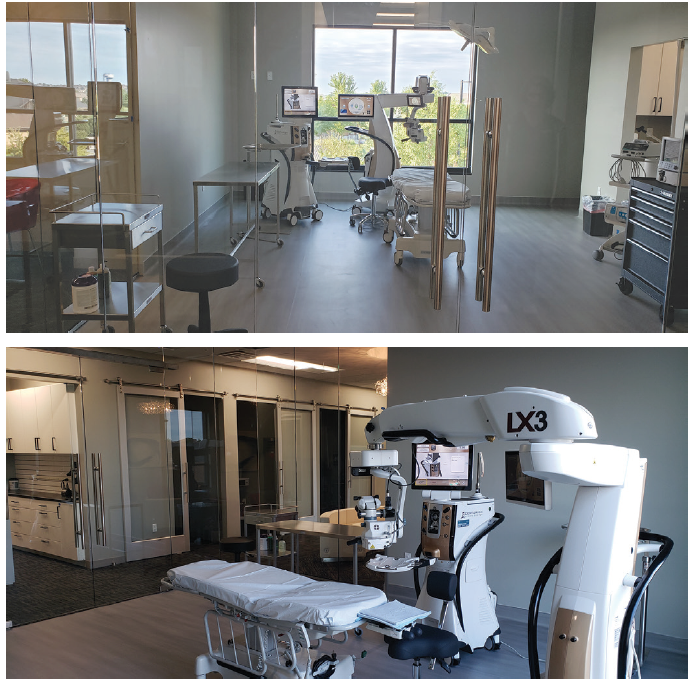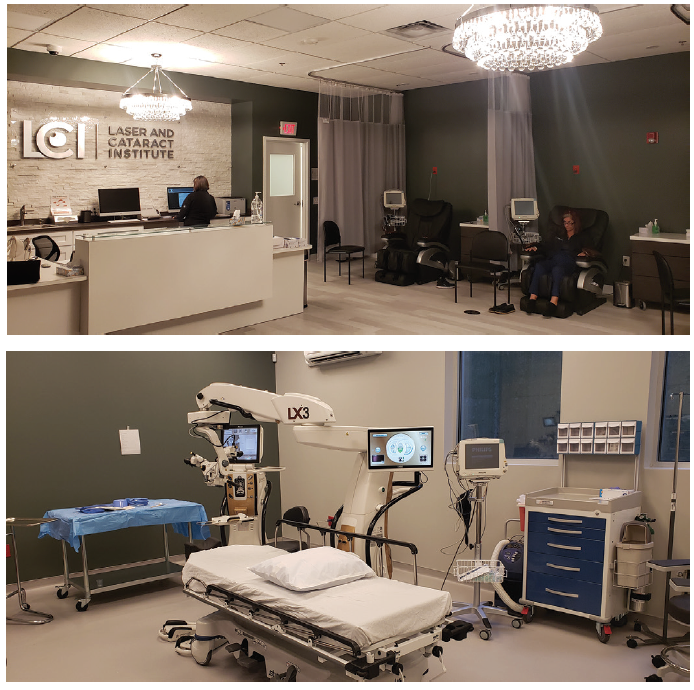
More than 50 years ago, ophthalmic surgeries were performed exclusively in hospitals. Patients experienced extended stays, long recovery times, high postoperative risks, and costs that were 25 times higher than those of today.1 In 1970, the first US ambulatory surgery center (ASC) opened, creating a high-quality and more cost-effective alternative to inpatient or outpatient hospital care.
The demand for ophthalmic surgery continues to grow with the aging of the baby boomer generation. By 2032, the number of individuals with cataracts in the United States is projected to be 38.5 million, increasing to 45.6 million by 2050.2 Additionally, the rapid growth of presbyopic refractive surgical procedures increases the demand further, which will result in a shortage of both ORs and surgeons. Clearly, another solution is needed.
Office-based surgery (OBS) provides an effective and safe solution to the shortage of ORs. OBS suites follow the same safety standards as ASCs and hospitals, are regulated in all 50 states, and operate under the physician’s license governed by the individual state board of medicine using either Class A (oral sedation, such as diazepam) or Class B (monitored) anesthesia. Similar to the shift that took place from hospital-based surgery to ASCs, the shift from ASCs to OBS is likely to become the standard for ophthalmic surgery in the future.
SAFE, EFFECTIVE, ADVANTAGEOUS
The adoption of OBS can be beneficial for patients and surgeons while maintaining safety and improving efficiency. When surgery takes place in the physician’s office, patient care is streamlined and more personalized. When patients are familiar with the environment and staff, their anxiety is reduced and they have a better overall experience. Additionally, the examination and surgery can be performed on the same day, eliminating redundant preoperative work and resulting in a more convenient and overall shorter surgical process. Lance Kugler, MD, of Omaha, Nebraska, worked with iOR Partners, the only company specializing in creating OBS suites, to upgrade his existing LASIK center for OBS. As Dr. Kugler stated, “Surgeons are used to taking patients to a third-party ASC and consider it routine, but, for patients, it’s a big deal to go to another entity that is new to them. Moving procedures into our own facility has removed that barrier and led to more patients choosing to have their procedures with us.”3
Of primary importance, OBS provides safe and effective outcomes comparable or superior to those performed in an ASC. Ianchulev and colleagues performed the largest US study to date investigating the safety and effectiveness of office-based cataract surgery performed in a minor procedure room.4 The retrospective study included 21,501 cataract surgeries in 13,507 patients (mean age, 72.6 ±9.6 years) conducted by Kaiser Permanente Colorado surgeons from 2011 to 2014. The authors found that OBS efficacy outcomes were consistently excellent, with a safety profile that would be expected of minimally invasive cataract procedures performed in ASCs and hospital outpatient departments. Phacoemulsification was performed in 99.9% of the cases and manual extracapsular extraction in the other 0.1%. Systemic comorbidities included hypertension (53.5%), diabetes (22.3%), and chronic obstructive pulmonary disease (9.4%).
Good visual outcomes and safety were reported in the study, with postoperative mean BCVA of 0.14 ±0.26 logMAR. Intraoperative ocular adverse events included capsular tears (0.55%) and vitreous loss (0.34%). Postoperative adverse events included iritis (1.53%), corneal edema (0.53%), and retinal tear or detachment (0.14%). No endophthalmitis was reported. Second surgeries were performed in 0.70% of treated eyes within 6 months. There were no life- or vision-threatening intra- or perioperative adverse events, and postoperative complications were low.
By integrating clinic and surgery in one location, physicians gain more control, flexibility, and ease of scheduling. They can provide better continuity of care and a more personalized patient experience, given that the examination and pre-, intra-, and postoperative care all take place within their offices. Performing surgery in an OBS suite allows physicians to gather complete and accurate patient outcomes data.
REDUCING COSTS
Office-based cataract procedures do not routinely require preoperative laboratory tests, which significantly reduces direct medical costs. Additionally, more than 95% of patients who qualify for OBS procedures do not use or require monitored anesthesia care, thus eliminating that $125 to $850 cost per case. This can result in an annual nationwide savings of $552 million to Medicare.1,4 Moreover, because OBS surgeries require fewer licensed personnel, staff costs can be reduced by 25%.
OBS suites also provide physicians with potential for increased revenue. With clinic and surgery in one location, physicians may increase patient capacity and retain surgical revenue within their practices. As Dr. Kugler observed, “By moving to an office-based setting, the ability to control costs is much greater, and therefore margins are higher compared to ASCs, which have many levels of overhead that add unnecessary expense to the process.”3
Furthermore, third-party payers including commercial insurers and Medicare Advantage plans often provide additional reimbursements for OBS procedures at rates similar to an ASC, depending on specialty and type of case.
ELIMINATING OBSTACLES TO BUILDING an OBS model
There are numerous advantages to adopting OBS, but many physicians have not considered it because they do not have knowledge of the process. There is extensive research that goes into planning for the space and understanding the costs involved in an OR build-out. Some may assume that they don’t have the space necessary to create an OBS suite, although many existing LASIK suites are eligible to serve as an OBS suite with no additional construction. Further, as little as 700 ft2 of space taken up by existing procedure rooms can be converted for OBS.
Others may have concerns about insurance accreditation and compliance, equipment needs, surgical staff training, and financial exposure. All of these are legitimate concerns, but the fact is that more than 100 ophthalmology OBS suites have been successfully established in the United States by iOR Partners (Figures 1 and 2). Dr. Kugler, who upgraded his existing LASIK suite with iOR Partners, said he found the process to be fast and seamless.

Figure 1. ART Vision, located in Sioux Falls, South Dakota, office-based surgical suite developed with iOR Partners.

Figure 2. Laser and Cataract Institute, located in Omaha, Nebraska, office-based surgical suite developed with iOR Partners.
Just as an ASC provides everything the physician needs, iOR Partners makes the OBS conversion a turnkey operation by assuming responsibility for the entire process—from initial planning through ongoing support—all with limited or no financial exposure to the practice. iOR Partners provides the essential equipment and maintenance, surgical supplies, and accreditation and compliance consulting services for an OBS suite.
The company’s financial model eliminates exposure for physicians. It is based on a 36-month agreement under which practices pay an all-inclusive fee per surgery. After the 36-month period, the practice retains complete ownership of all equipment and supplies with no further financial obligation.
iOR Partners works directly with insurance companies to help practices receive reimbursement for their office-based procedures. The company also provides guidance for practice profitability, including a pricing strategy recommendation to find the right balance between patient volume and fee levels.
CONCLUSION
With the continually growing demand for cataract surgery, OBS is poised to become the new standard as a safe, cost-effective alternative to ASCs that is beneficial for both the patient and the practice.




